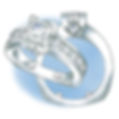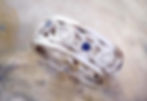Help! My Ring Flops
How to solve and prevent a ring that constantly spins on your finger. A common problem that can turn the ring you love into a constant annoyance; here's a quick review of how we can solve this problem and how to prevent it in the first place.
1. Size Your Ring ProperlyA loose-fitting ring is the simplest reason your ring may spin around on your finger. Luckily having your ring resized is an easy and often affordable solution. A well-fitting ring should not feel tight or uncomfortable but should not slide up and down your finger without being pulled. |
 2. Sizing Beads and the “Finger to Knuckle Ratio.”For those of us with more prominent knuckles sizing beads are a great solution. We add two small balls of metal to the inside bottom of the shank. These beads gently hold the ring in place while allowing you to get the ring on and off past your knuckle. This relatively inexpensive and straightforward repair provides a comfortable and permanent solution.Image Credit: GIA.edu |
 3. Euro ShankA euro shank is also a great solution; giving the ring a square profile on the outer edge, it fits more snugly against your fingers, preventing spinning as you wear it. Older rings can be re-shanked at the shop. This means we cut away the old band and replace it with a new one. However, this can be a pricey repair due to work involved and the amount of metal replaced. |
 4. Adding a Band or Ring EnhancerA ring enhancer consists of two connected bands made to match your ring so that you can slide your solitaire in the center and wear them as one ring. Enhancers not only add a little extra sparkle and compliment your ring but also provide stability and prevent the ring from spinning around. Likewise, adding a single matching band to fit in front or behind your existing ring offers extra stability and support. |
 5. Hinged or Arthritic ShankA ring with a hinged shank (also called an arthritic shank) has a hinge on the bottom that allows you to open the ring, put it onto your finger, and close it again without squeezing it painfully past the knuckle. Hinged shanks are a great solution and allow for a truly perfect fit; however, they are costly. Libby recommends designing your ring with a hinged shank from the beginning if you know this may be a problem and you plan on wearing the ring every day for years to come. This offsets the cost, making it an excellent investment that ensures you will be able to wear your ring as your knuckles change over the years. |
  6. Balanced DesignThe best solution! As we know, gravity always wins. A well-fitting ring that still spins is caused when a ring is unbalanced. To sit on your finger correctly, you must have a band that correlates to your diamond or gemstone size. A large solitaire needs a wider band to support it so it can be worn comfortably. Stacey often recommends continuous designs which look the same from all sides. If you don't have a large solitaire and aren't necessarily looking for one, creating a ring with a continuous design guarantees you'll never have to worry about the ring's position on your finger. When you’re ready to design your next piece or need to reset your existing solitaire, Stacey and Ashley will guide you through the design aspects, allowing you to enjoy your ring without your solitaire ending up in the palm of your hand. |